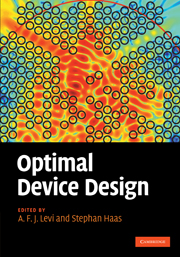Book contents
- Frontmatter
- Contents
- Preface
- Acknowledgements
- 1 Frontiers in device engineering
- 2 Atoms-up design
- 3 Electron devices and electron transport
- 4 Aperiodic dielectric design
- 5 Design at the classical–quantum boundary
- 6 Robust optimization in high dimensions
- 7 Mathematical framework for optimal design
- 8 Future directions
- Appendix A Global optimization algorithms
- About the authors
- Index
- References
1 - Frontiers in device engineering
Published online by Cambridge University Press: 04 May 2010
- Frontmatter
- Contents
- Preface
- Acknowledgements
- 1 Frontiers in device engineering
- 2 Atoms-up design
- 3 Electron devices and electron transport
- 4 Aperiodic dielectric design
- 5 Design at the classical–quantum boundary
- 6 Robust optimization in high dimensions
- 7 Mathematical framework for optimal design
- 8 Future directions
- Appendix A Global optimization algorithms
- About the authors
- Index
- References
Summary
Introduction
Today, nanoscience promises to provide an overwhelmingly large number of experimentally accessible ways to configure the spatial position of atoms, molecules, and other nanoscale components to form devices. The central challenge of nano-technology is to find the best, most practical, configuration that yields a useful device function. In the presence of what will typically be an enormous non-convex search space, it is reasonable to assume that traditional ad hoc design methods will miss many possible solutions. One approach to solving this difficult problem is to employ machine-based searches of configuration space that discover user-defined objective functions. Such an optimal design methodology aims to identify the best broken-symmetry spatial configuration of metal, semiconductor, and dielectric that produces a desired response. Hence, by harnessing a combination of modern computer power, adaptive algorithms, and realistic physical models, it should be possible to seek robust, manufacturable designs that meet previously unobtainable system specifications. Ultimately one can envision a design process that simultaneously is capable of basic scientific discovery and engineering for technological applications.
This is the frontier of device engineering we wish to explore.
The past success of ad hoc design
For many years an ad hoc approach to device design has successfully contributed to the development of technology. For example, after identifying the cause of poor device performance one typically tries to create a solution by modifying a process or fabrication step. The result is usually a series of innovations heavily weighted towards incremental, and hence small, changes in previous practice.
- Type
- Chapter
- Information
- Optimal Device Design , pp. 1 - 31Publisher: Cambridge University PressPrint publication year: 2009

